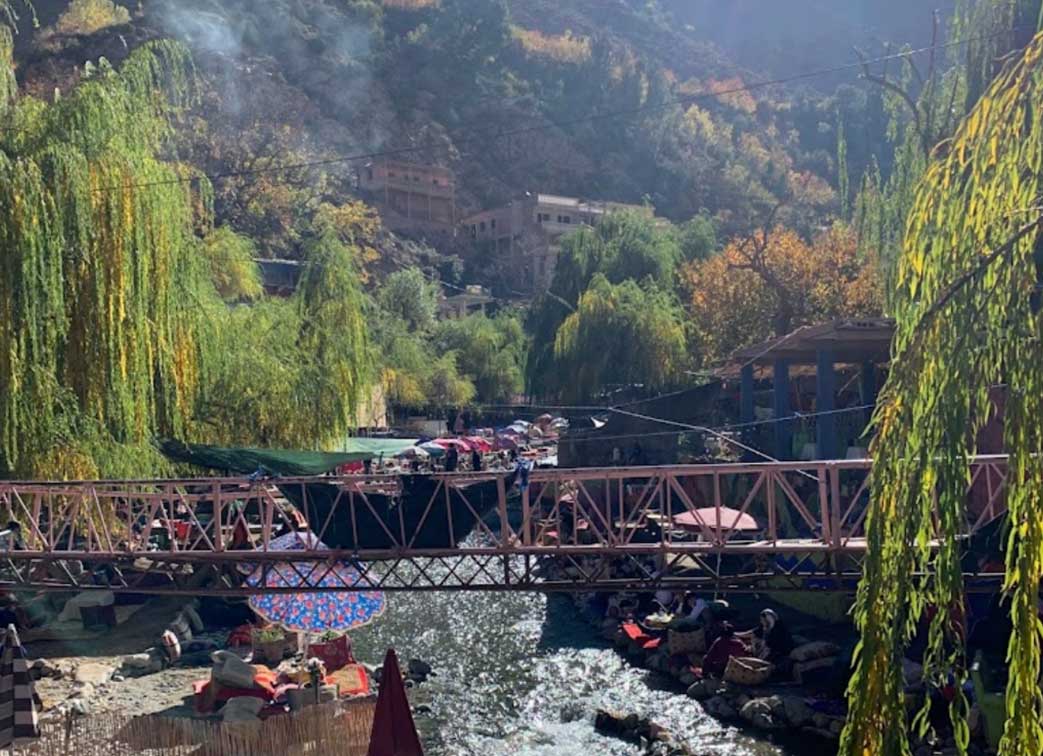Ourika Valley: A Verdant Escape in the Shadow of the Atlas Mountains
Table of Contents
Introduction to the Ourika Valley
Nestled within the majestic Atlas Mountains, just an hour’s drive from Marrakech, the Ourika Valley stretches through vibrant landscapes marked by lush meadows, terraced gardens, and Berber villages clinging to the mountainsides. A popular day-trip destination for both tourists and locals, the valley offers a tranquil escape from the bustling streets of Marrakech, presenting opportunities for hiking, discovering rural Moroccan culture, and simply enjoying the cooler climate and scenic beauty.
Geographic and Environmental Overview
The Ourika Valley follows the Ourika River as it winds from the High Atlas mountains down towards the plains near Marrakech. The valley is renowned for its rich biodiversity, supported by the river that sustains a variety of ecosystems from arid slopes to fertile terraces. Throughout the valley, small villages showcase the traditional Berber architecture of mud-brick homes, while vibrant fields and orchards paint the landscape in hues of green and gold.
Cultural Significance and Lifestyle
Home to a resilient Berber community, the Ourika Valley is a living museum of Morocco’s indigenous Amazigh culture. The valley not only offers a glimpse into the daily lives of the Berber people but also demonstrates their close relationship with the land. Traditional practices such as agriculture, weaving, and pottery are still fundamental aspects of life here, offering visitors a deeper understanding of rural Moroccan culture.
Attractions and Activities
Hiking and Nature Walks
Ourika Valley is a haven for nature lovers and hikers. Trails range from gentle walks along the river to more challenging hikes up the mountain slopes, including the ascent to Setti Fatma’s famous waterfalls. These cascades, which are a highlight for many visitors, offer a refreshing reward after a vigorous hike, with pools suitable for a cool dip during the warmer months.
Setti Fatma Village
The village of Setti Fatma marks the end of the main road through the Ourika Valley and serves as the starting point for treks to the seven waterfalls. This charming village is also a good spot to enjoy local cuisine in one of its many riverside cafés, where visitors can savor tagines and mint tea while enjoying the view of the water and greenery.
Botanical Discoveries
The valley is known for its unique flora, including a variety of aromatic and medicinal plants. The Bio Aromatic Garden of Ourika offers guided tours that educate visitors about the cultivation and uses of these plants, reflecting the locals’ deep knowledge of their natural environment.
Tnin Ourika Market
For those interested in experiencing a traditional Berber market, the Tnin Ourika market, which takes place every Monday, is a cultural spectacle. Here, locals from the surrounding villages come to sell their produce, crafts, and livestock in a vibrant, colorful setting that offers a snapshot of rural commerce.
Ecotourism and Sustainability
Awareness of sustainability and ecotourism is growing in the Ourika Valley. Many local businesses and tour operators focus on preserving the natural and cultural heritage of the area. Visitors are encouraged to respect the environment and support local artisans by purchasing authentic handmade products.
Culinary Delights
The culinary experiences in Ourika Valley reflect the agricultural richness of the area. Local dishes are made with fresh, organically grown produce. Berber pancakes, fresh fruit, nuts, and traditional Moroccan salads are readily available from local vendors, providing tastes that are as fresh as the air.
Accommodations
Accommodation options in the Ourika Valley range from luxury hotels and eco-lodges to simpler guesthouses that offer a more authentic experience. Many of these are designed to blend seamlessly with the natural environment, providing stunning views of the valley and mountains.
Best Time to Visit
The Ourika Valley can be visited year-round, but spring (April to June) and autumn (September to November) are particularly magical. During these seasons, the weather is most favorable for outdoor activities, and the landscape is at its most vibrant, with spring flowers or autumn leaves adding splashes of color.
How to Get There
The Ourika Valley is most accessible by road from Marrakech. Visitors can hire a private car, take a taxi, or join an organized tour. The drive itself, which offers scenic views of the mountains and plains, is an integral part of the experience.
Conclusion
The Ourika Valley is more than just a destination; it is an experience that offers a blend of natural beauty, adventure, and cultural immersion. Whether you are trekking to the waterfalls, exploring Berber villages, or simply relaxing by the river, the valley provides a peaceful yet enriching escape from the city life, making it a must-visit for anyone traveling to Morocco.
Additional Resources
For a fuller experience of the High Atlas region, consider visiting nearby Asni and Imlil. Asni, known for its lively Saturday market, provides a picturesque setting and a base for exploring Mount Toubkal. Imlil, further into the mountains, is the primary departure point for treks up Mount Toubkal. Both locations offer a rich mix of natural beauty and traditional Berber culture, complementing a visit to Ourika Valley perfectly.




Comments are closed